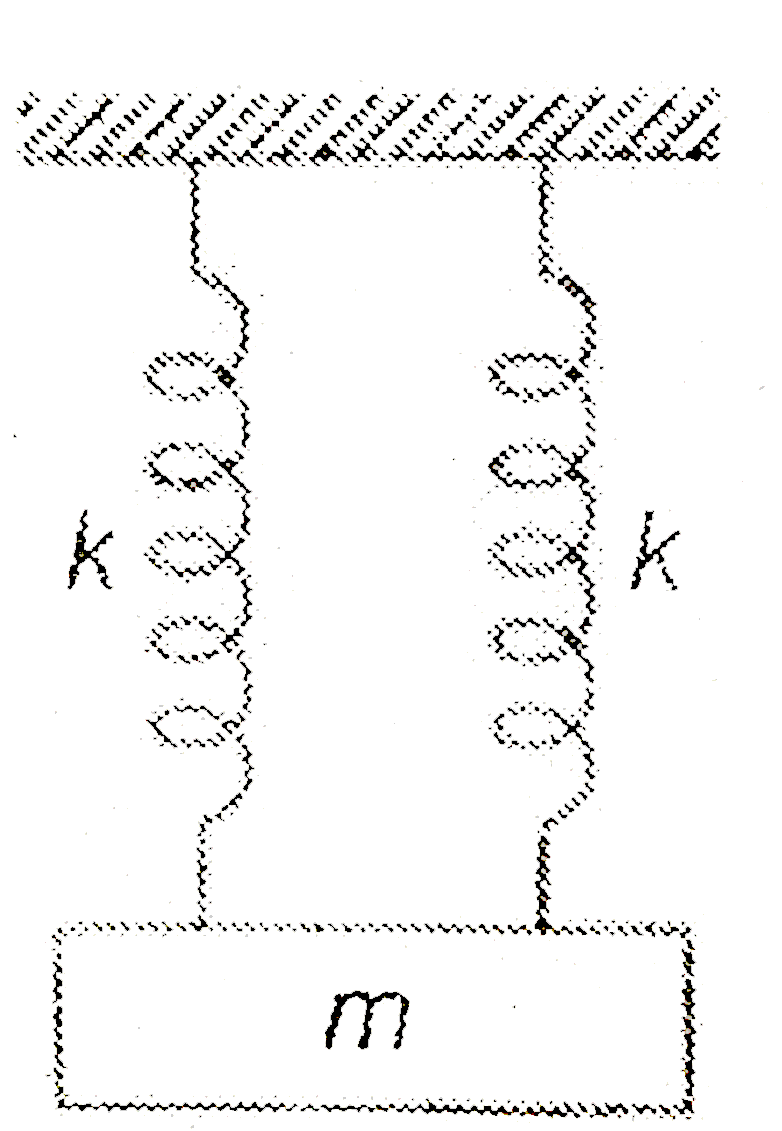Spring is pulled down by 2 cm. What is amplitude of its motion?
0 cm
6 cm
2 cm
4 cm
The correct Answer is:C
To solve the problem of determining the amplitude of motion when a spring is pulled down by 2 cm, we can follow these steps:
1. Understanding the Problem:
A spring is pulled down by 2 cm from its equilibrium position. We need to find the amplitude of its motion.
2. Definition of Amplitude:
The amplitude of a spring's motion is defined as the maximum displacement from its equilibrium position.
3. Identify the Displacement:
In this case, the spring is pulled down by 2 cm. This displacement from the equilibrium position is what we need to consider.
4. Amplitude Calculation:
Since the spring is pulled down by 2 cm, this value directly represents the maximum displacement from the equilibrium position. Therefore, the amplitude A of the spring's motion is equal to the displacement:
A=2cm
5. Conclusion:
The amplitude of the spring's motion when it is pulled down by 2 cm is 2 cm.
Final Answer:
The amplitude of the spring's motion is 2 cm.
---
A spring is pulled down by 2 cm from its equilibrium position. We need to find the amplitude of its motion.
The amplitude of a spring's motion is defined as the maximum displacement from its equilibrium position.
In this case, the spring is pulled down by 2 cm. This displacement from the equilibrium position is what we need to consider.
Since the spring is pulled down by 2 cm, this value directly represents the maximum displacement from the equilibrium position. Therefore, the amplitude A of the spring's motion is equal to the displacement:
A=2cm
The amplitude of the spring's motion when it is pulled down by 2 cm is 2 cm.
The amplitude of the spring's motion is 2 cm.
Topper's Solved these Questions
- OSCILLATIONS BOOK - TARGET PUBLICATIONCHAPTER - OSCILLATIONS EXERCISE - EVALUATION TEST
14 Videos
- OSCILLATIONS BOOK - TARGET PUBLICATIONCHAPTER - OSCILLATIONS EXERCISE - Critical thinking
81 Videos
- MODEL QUESTION PAPER BOOK - TARGET PUBLICATIONCHAPTER - MODEL QUESTION PAPER EXERCISE - MODEL QUESTION PAPER -II
47 Videos
- QUESTION PAPER 2019BOOK - TARGET PUBLICATIONCHAPTER - QUESTION PAPER 2019EXERCISE - MCQ
45 Videos
Similar Questions
A block whose mass m is 680g is fastened to a spring whose spring constant k is 65N/m. The block is pulled a distance x=11cm from its equilibrium position at x=0 on a frictionless surface and released from rest at t= 0.
What is the amplitude of the oscillation?
View SolutionForce constant of a weightless spring is 16 N/m. A body of mass 1.0 kg suspended from it is pulled down through 5 cm from its mean position and the released. The maximum kinetic energy of the system (spring+body) will be (0.0x) J. Find value of x.
View Solution
Knowledge Check
Mass suspended to a spring is pulled down by 2.5 cm and let go. The mass oscillates with an amplitude of
A2.5 cmB5 cmC7.5 cmD10 cmA spring of length 0.4 m, fixed at one end in the vertical direction is extended by 5 cm, by attaching a mass of 2 kg. Then it is further pulled by 5 cm and left to itself. What is the final potential energy ? What is the amplitude of oscillation ? (g=10m/s2)
A2 J, 10 cmB1 J, 10 cmC2 J, 5 cmD3 J, 10 cmA mass m, which is attached to a spring with spring constant k, oscillates on a horizontal table, with amplitude A. At an instant when the spring is streched by √3A/2, a second mass m is dropped vertically onto the original mass and immediately sticks to it. what is the amplitude of the resulting motion-
A√32AB√78AC√1316AD√23A
On suspending a heavy block of 2 kg from a massless spring, an extension of 5 cm is produced in the spring. If the block is further pulled down by 10 cm and then released then find the kinetic energy of oscillation of the spring.
View SolutionA particle is performing a linear S.H.M. If at time t=0, its displacement is 1 cm, its velocity is πcm/sec and its angular frequency is πrad/s, then the amplitude of its motions is
View SolutionPassage III A block of mass m =1/2 kg is attached with two springs each of force contant k=10N/m as shown. The block is oscillating vertically up and down with amplitude A=25cm. When the block is at its mean position one of the spring breaks without changing momentum of block.

What is the new amplitude of osciallation of the block.
View SolutionForce constant of a weightless spring is 16Nm−1. A body if mass 1 kg suspended from it is pulled down through 5 cm from its mean position and then released. The maximum kinetic energy of the body will be
View SolutionA body executing linear simple harmonic motion has a velocity of 3 cm/s when its displacement is 4 cm and a velocity of 4 cm/s when its displacement is 3 cm. Then amplitude of oscillation with be
View Solution
